International Journal of Wireless and Microwave Technologies @ijwmt
Статьи журнала - International Journal of Wireless and Microwave Technologies
Все статьи: 574
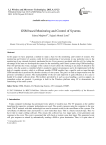
GSM based Monitoring and Control of Systems
Статья научная
In this paper we have proposed a method to make a base for the monitoring and Control of systems. The monitoring and Control of systems could be from monitoring of movements in any particular area to the monitoring of any external electrical, mechanical device. Every person is pocketed with the cell. So, taking the advantage of the same we developed the system for the monitoring and Control system using GSM technology. This will provide the owner, manager of the system to know about the working or any kind of default in the system. Also the system is controlled which is needed in special circumstances and is be implemented with the help of complete circuitry which is a different module (DTMF module) has a specific code as input through GSM encoder that is processed by decoder circuitry of our system. The goal is to find an improvement over the previous surveillance systems .The maintainability of the new and improved is quite efficient as it is easy to handle it by simple software demo. The facilities provided by it such as easy handling, a secrecy support, an immediate action are granted. A prototype is built in the Windows platform using C# to demonstrate the functioning of the entire system.
Бесплатно
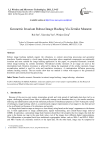
Geometric Invariant Robust Image Hashing Via Zernike Moment
Статья научная
Robust image hashing methods require the robustness to content preserving processing and geometric transform. Zernike moment is a local image feature descriptor whose magnitude components are rotationally invariant and most suitable for image hashing application. In this paper, we proposed Geometric invariant robust image hashing via zernike momment. Normalized zernike moments of an image are used as the intermediate hash. Rotation invariance is achieved by taking the magnitude of the zernike moments. Image normalization method is used for scale and translation invariance. A randomization diffusion processing enhance hashing security. The test results show that our method is robust with respect to the geometrical distortions and content preserving processing.
Бесплатно
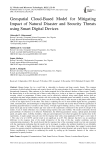
Статья научная
Human beings live in a world that is vulnerable to disasters and huge security threats. The common occurrence of global natural disasters and security threats call for major attention by the government of nations and the International community. Man continues to live under perpetual fear of the unknown because of these events. Notably, the human being is at the receiving end of these events either as a victim or at times as a perpetrator. Locating and rescuing victims or perpetrators of these events can be effectively achieved using smart digital devices that are configured with their unique identities and this will aid in achieving sustainable peace and stability in society. Equally, the global proliferation of digital devices is always on the rise; hardly today is there anyone on the planet earth without a form of one digital device or the other. This study is exploring the use of smart mobile digital devices, geospatial, cloud, communication, and technologies in mitigating the impact of natural and security threats with the significance of promoting peaceful human co-existence in the society. A Google App for finding a device, clock- timer app, an Internet speed check app and an online weather app were used for the experiments conducted for the proof of concept of the model. A test of model robustness was evaluated using response time and visibility. The model consistently showed good attributes of robustness in its behavior. Furthermore, the following parameters: latency, upload speed, download speed, air quality index, visibility, humidity, wind gust and temperature were observed against the response time in the experiments. A single sample (one-tail) t-test for the response time with a mean population of 0.9 gave a t-test value of 1. The value of p is 0.162791 and the result is not significant at p<.05. This indicates that there was no significant difference in the response time of the model irrespective of the time of the day, weather conditions, and the communication parameters. The result showed that the response time of the conceptual model was fast and consistent with the experiments indicating that the model can be leveraged, to address the problem identified in an affordable manner. The study is highly significant due to the fact that exploring the technologies that support location-based systems has greater potential in addressing the problem occasioned by natural disasters and security threats to humans. Future consideration is focused on enhancing the model by scaling up the biometrics features of the victim or perpetrator for speedy location.
Бесплатно
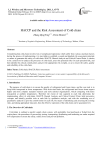
HACCP and the Risk Assessment of Cold-chain
Статья научная
Considering that cold-chain involves lots of complicated operations which suffer from various uncertain factors during the process of implementing, it is inevitable to establish a sound and detailed risk assessment principle or means to guarantee the safety of cold-chain. HACCP, Hazard Analysis and Critical Control Point, is chosen to be a useful tool to analyze the processes of cold-chain, assess the potential risks for each operation link, and then identify the critical control points and give the appropriate risk weights, so as to ensure the safety, quality and reliability of the cold-chain.
Бесплатно

Статья научная
The last few years have witnessed exponential rise in internet-of-things (IoT) systems for communication; yet, ensuring quality-of-service (QoS) and transmission reliability over mobile topology has remained challenge. Despite the fact that the use of software defined networks (SDN) have enabled IoTs to achieve resource efficiency and reliability; it doesn’t guarantee optimality of the solution over the network with high dynamism and non-linearity. Moreover, the major at hand SDN-IoT protocols have applied standalone node parameters to perform routing and allied transmission decision that confine its robustness over dynamic network topologies. Interestingly, none of the state-of-art SDN-IoT protocols could address the problem of iterative link-outage and corresponding network discovery cost. Furthermore, even multi-path selection strategies too failed in addressing the problem of joined shortest path selection and allied iterative link-outage due to the common node failure. Considering it as motivation, in this paper a novel and robust Heuristic-Driven Disjoint Alternate Path Switching -based Fault-Resilient Multi-Constraints Routing Protocol for SDN-mIOT system (HDAP-SDNIoT) is proposed. HDAP-SDNIoT exploits multiple dynamic parameters like medium access control information, flooding and congestion probability information. HDAP-SDNIoT exploits aforesaid node parameters to perform node profiling that serves multi-constraints best forwarding path selection. The proposed model retrieves multiple best alternating paths which are fed as input to the Adaptive Genetic Algorithm (AGA) that retains three disjoint best forwarding paths. HDAP-SDNIoT protocol at first avoids any malicious node(s) to become forwarding node, while it provides auto-switching capability to the forwarding node to select a disjoint forwarding alternate path in case of any link-outage in current forwarding path. _Simulation results confirm robustness of the proposed model in terms of high packet delivery rate of 96.5%, low packet loss rate 3.5% and low delay of 211 ms that affirms its suitability towards real-time SDN-mIoT applications.
Бесплатно
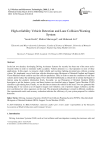
High-reliability vehicle detection and lane collision warning system
Статья научная
In the last two decades, developing Driving Assistance Systems for security has been one of the most active research fields in order to minimize traffic accidents. Vehicle detection is a vital operation in most of these applications. In this paper, we present a high reliable and real-time lighting-invariant lane collision warning system. We implement a novel real-time vehicles detection using Histogram of Oriented Gradient and Support Vector Machine which could be used for collision prediction. Thus, in order to meet the conditions of real-time systems and to reduce the searching region, Otsu’s threshold method play a critical role to extract the Region of Interest using the gradient information firstly. Secondly, we use Histogram of Oriented Gradient (HOG) descriptor to get the features vector, and these features are classified using a Support Vector Machine (SVM) classifier to get training base. Finally, we use this base to detect the vehicles in the road. Two sets generated the training data of our system a set of negative images (non-vehicles) a set of positive images (vehicles), and the test is performed on video sequences on the road. The proposed methodology is tested in different conditions. Our experimental results and accuracy evaluation indicates the efficiency of your system proposed for vehicles detection.
Бесплатно
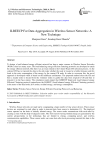
ILBEECP for data aggregation in wireless sensor networks: a new technique
Статья научная
To design a load balanced energy efficient network has been a major concern in Wireless Sensor Networks (WSNs) since last many years. The load balancing energy-efficient clustering protocols are developed to attain the energy efficient network. But there was an issue related to the Cluster Head (CH) selection process. As the selected CH has to transmit the data to the sink node whether the node is located at a farther distance and this leads to the extra consumption of the energy by the current CH node. In order to overcome this, the novel approach is developed which is based on the multilayer architecture. The proposed method elects the CH and then a Leader node is elected from the volunteer nodes to gather the data from respective CH and then to transmit it to the base station. The simulation results depict that ILBEECP (Improved Load balanced energy Efficient Clustering protocol) outperforms the LBEECP (Load balanced energy Efficient Clustering protocol) in the terms of the dead node, alive nodes, residual energy, and energy consumption.
Бесплатно
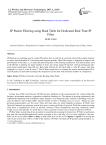
IP Packet Filtering using Hash Table for Dedicated Real Time IP Filter
Статья научная
IP filtering is a technique used to control IP packets flow in and out of a network where Filter engine inspects at source and destination IP of incoming and outgoing packets. Here Filter engine is designed to improve the performance of the filter, i.e. to reduce the processing time of the filtering mechanism. The data structure used in the IP filter is hashing, for larger number of hosts and variety ranges IP network of hosts hashing provides much better performance than link list. Here hash function for the hash table is valid IP classes with host capacities i.e. class A, class B, class C. The IP filter engine have to compare the source and destination IP of each IP packet. In hash table technique the comparison can be done with minimum number of comparisons.
Бесплатно
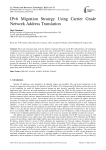
IPv6 Migration Strategy Using Carrier Grade Network Address Translation
Статья научная
Due to the increased strain each new Internet-connected item puts on the IPv4 infrastructure, the emergence of additional Internet-connected places and devices has accelerated IPv4 exhaustion. Service providers have been obliged to invest in infrastructure to handle greater traffic due to unexpected growth in subscribers and linked IoT devices. Service providers are struggling to maintain growth and business continuity due to the expiration of IPv4 globally and the adoption of IPv6. There is strongly a need to address both a short-term solution for the maintenance of their current IPv4 address allocation and a long-term solution for a seamless transition to an IPv6 infrastructure, various service providers will need to design an address translation strategy. This paper presents a solution using CGNAT towards the migration of IPv6 networks. A general overview of the various parts needed to manage the depletion of IPv4 addressing and the engagement of full carrier grade network address translation solution is also discussed in this paper along with the different types of NAT.
Бесплатно
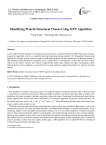
Identifying Protein Structural Classes Using MVP Algorithm
Статья научная
A new method for the prediction of protein structural classes is constructed based on MVP (Maximum variance projection) algorithm, which is a manifold learning-based data mining method. DC (Dipeptide Composition) and PseAA (Pseudo Amino Acid) are used as conditional attributes for the construction of decision system. A DR (Dimensionality Reduction) algorithm, the so-called MVP is introduced to reduce the decision system, which can be used to classify new objects. Experimental results thus obtained are quite encouraging, which indicate that the above method is used effectively to deal with this complicated problem of protein structural classes.
Бесплатно
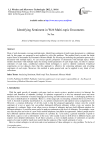
Identifying Sentiment in Web Multi-topic Documents
Статья научная
Most of web documents coverage multiple topic. Identifying sentiment of multi-topic documents is a challenge task. In this paper, we proposed a new method to solve this problem. The method firstly reveals the latent topical facets in documents by Parametric Mixture Model. By focusing on modeling the generation process of a document with multiple topics, we can extract specific properties of documents with multiple topics. PMM models documents with multiple topics by mixing model parameters of each single topic. In order to analyze sentiment of each topic, conditional random fields techniques is used to identify sentiment. Empirical experiments on test datasets show that this approach is effective for extracting subtopics and revealing sentiments of each topic. Moreover, this method is quite general and can be applied to any kinds of text collections.
Бесплатно
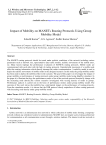
Impact of Mobility on MANETs Routing Protocols Using Group Mobility Model
Статья научная
The MANET routing protocols should be tested under realistic conditions of the network including various parameters such as network size, representative data traffic models, realistic movements of the mobile users, etc. Many factors impinge the performance evaluation of MANETs routing protocols. Mobile nodes are communicated with each other with the help of routing protocols. Unpredictable movement of a mobile node affect the routing information which directly interrupt the subsist communication. A mobility model is used to depict the realistic movements of mobile nodes in the designed scenario. In this study the group mobility model has been used to deploy the mobility effect in the scenario. The goal of this paper is to investigate the impact of group mobility on performance of routing protocols under group mobility model using QualNet simulator. In the paper it is illustrate that how the performance results of an ad hoc network protocol drastically change with the increasing node density.The various scenarios investigated with varying density of nodes in groups. Performance analysis is carried out on the basis of performance metrics under group mobility model. The outcome of this work shows that mobility has a detrimental impact on the performance of routing protocols. From the simulation results, it is shown that the DSR protocol clearly outperform all other routing protocols with increasing node density under group mobility model.
Бесплатно
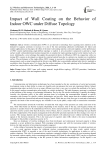
Impact of Wall Coating on the Behavior of Indoor OWC under Diffuse Topology
Статья научная
Optical wireless communication (OWC) is an innovative technology that is gaining more attention as the demand for capacity continues to increase. It is one of the most promising alternative technologies for indoor and outdoor applications. In this paper, the effect of the inner wall coating material, color and roughness on the performance of OWC system implementing single-diffuse topology is studied. A new procedure is proposed to generate a rough surface model with predetermined statistical properties to simulate the matte painting material on the internal walls of a room. Additionally, a new technique that applies the geometrical theory of diffraction (GTD) in conjunction with a ray tracing (RT) scenario is developed to evaluate the scattered optical beam due to a primary ray incident on a Lambertian surface. The performance of the single-diffuse OWC strategy is assessed by investigating some important performance measurements such as signal strength and the bit error rate (BER) due to unavoidable ambient light which is modeled as an additive white Gaussian noise. It is shown that the surface roughness of the matte painting on the Lambertian diffuse surface has a major effect on the indoor OWC system performance.
Бесплатно
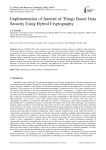
Implementation of Internet of Things Based Data Security Using Hybrid Cryptography
Статья научная
Internet of Things (IoT) is the current trends in tracking the variation of process variables in plant operations. The security threats and security issues continues to rise due to the wide usage of internet. The hybrid cryptography is proposed that involves symmetric AES, asymmetric RSA and hash functions all together enhance the security. The key length of this proposed symmetric AES encryption is 128-bit, RSA public key encryption is 1024-bit and 128-bit message digest is generated from the hash algorithm. It offers low latency in executing the proposed encoding and decoding algorithm. It is developed and verified in real-time environment using embedded system with internet of things. It assures data security and allows only authorized parties to monitor the plant parameters through the wireless networks. It preserves the intruders from gathering and modifying the sensitive plant information. It is suitable for protecting the plant parameters over the wide range of industrial applications.
Бесплатно

Implementation of a Locator-Based Route Switching Scheme for Improved Routing in Proxy Mobile IPv6
Статья научная
Proxy Mobile IPv6 (PMIPv6) is a promising IP mobility protocols that is being deployed in emerging wireless technologies. This however has a non-optimal packet route as a result of the triangular routing problem. This creates a bottle neck at the Local Mobility Anchor (LMA) thereby increasing packet delays. This paper presents the implementation of a locator-based route switching scheme on OPNET Modeler. The Mobility Access Gateway (MAG) and the LMA were enhanced by making them intelligent. This enables them to be able to check the position of the Corresponding Node (CN) with respect to the Mobile Node (MN) and also determine the available bandwidth on each link. From the checks made, a three-stage decision process is used to switch routing to the most optimal route that guarantees the best QoS. Node Models were developed for the MAG and LMA, network models were deployed and simulation tests were carried out. The results show that the developed scheme switched packets to a more optimal route according to the designed algorithm. The impact of this switching on differences between transmitted throughput at MN and the received throughput at CN was also evaluated. The receiver activity result shows a reduction in the bottleneck at the LMA-MAG link. The end-to-end delay results show over 50 milliseconds drop in packet delay as a result of the switching to a more optimal route. This shows that the packet delays result from the congestion at the LMA-MAG interface due to suboptimal routing.
Бесплатно

Implementing Video OCR along with SWT Technique for Video indexing and Analysis
Статья научная
The main purpose of this paper is to expand the usage of OCR (Optical character recognition) as this is only implemented over images and to extend this Video OCR is introduced in a way to help to retrieve the information from the video without playing the video. Video OCR is executed with the assistance of OpenCv2 module and PyTesseract [7] at the side of SWT approach which all pretty collectively make an ideal aggregate to offer an appropriate content from the video (i.e., Lecture video or any kind of video which has slides or text on the background of the video) [2,4].This technique is performed in a well-designed along with easy steps to provide us an correct end result of the facts from the video into textual files. In addition to this we also added Speech Recognition module within the project to support the video along with the text file. This speech delivered by the faculty (i.e., instructor/educator/teacher), or an educator will be also resulted in a text file.
Бесплатно

Improved Hybrid Architecture to Mitigate Free Riding in P2p Network
Статья научная
Peer-to-peer (P2P) networks rely heavily on resources shared by peers in the network as a result of this mitigating free riding in the network is very crucial in a P2P system. In this work, we introduced a dynamic grace period allocation and a content scanning mechanism to a hybrid P2P architecture to mitigate free riding and prevent peers from uploading repeated and fake files within the network. The method introduced was simulated using Python programming language with peers selected at random to upload and download files representing a typical scenario of a P2P network. From the range of 0-500 and 600-2000, twenty different peers were selected at random the first scenario represents few peers and the second scenario represents many peers for analysis and experimentation purposes and also for the different percentages of free riders used for the experiment, this was chosen at random. Finally, we compared our method with a credit-based approach (CBA) that uses a common grace period assigned to peers in the network. Then, for the performance evaluation metric, we used the total uploads and downloads, contributing peers uploads and downloads, free rider peers uploads and downloads, and repeated and fake files detected gotten from the simulation result to evaluate the model and analyze the outcome of the experiments. Results from the simulation revealed that the Dynamic grace period approach (DGA) is 25-70% more effective than CBA in maintaining contributing peer activity and preventing the spread of repeated and fake files,while also achieving lower latency, higher throughput, and better quality of service (QoS) across diverse network conditions, particularly in high free-rider environments.
Бесплатно

Improved Route Discovery Scheme under Blackhole Attack in MANET
Статья научная
A Mobile Ad Hoc Network (MANET) consists of numerous wireless mobile devices. It is a self-organizing network and does not require any pre-established infrastructure. Communication between devices sets up without any dedicated centralized server. A malicious node takes advantage of this vulnerability and attempts to integrate into the network in order to lower its overall performance. In MANET, one of the most dangerous types of attacks is the blackhole node assault. In order to join the route, a node with blackhole assault wrongly sends route information to the source node during the route discovery process and degrades the network performance. In order to address this problem, a novel Blackhole Detection Algorithm (BHDA) has been proposed in this work. To determine the existence of blackhole nodes, the protocol takes into account various factors including number of route request packets (RREQ) received, number of RREQ packets forwarded, and number of route reply packets (RREP) transmitted by nodes throughout the route discovery process. Apart from this, each node maintains a local neighbourhood information and for that all neighbourhood node has to pass the check before becoming a neighbour. The simulation results prove that the proposed technique BHDA shows drastic improvement in network performance under blackhole attack.
Бесплатно

Статья научная
The design of a double layer stacked microstrip loop shaped patch antenna for multiband operation has been proposed. The design has been evolved following the iterations of a rectangular patch and a single layer loop patch structure. The material considered for the substrate of both the layers is 1.6 mm thick FR4 epoxy and the feeding technique used for the bottom patch is coaxial/ probe feed. The radiations from the bottom layer patch have been electromagnetically coupled to the upper layer patch. The main results including the reflection coefficient, bandwidth, radiation pattern, gain, directivity and VSWR for single frequency operation in each case have been discussed separately and finally compared. The comparison shows that the proposed stacked structure is clearly advantageous over the conventional rectangular patch and the single layer designed prototype in terms of the standard parameters that have been obtained. The three stage designs are useful to serve the X-band aviation applications including radio location and fixed mobile radio location.
Бесплатно

Improvement of ZigBee Using by Thread and Backpressure Algorithm
Статья научная
In wireless sensor networks, two approaches of tree and mesh routing are introduced to determine the path of packets during the transition process. Tree routing is a simple routing protocol with low overhead that in this protocol father-child bonds for packet transmission from the source to the destination is used. The biggest problem of routing is the increase of the number of mutations in comparison with other routing protocols. In order to improve this problem, protocols have been introduced in recent years to determine a shortcut path on the basis of the tree routing. This study is an attempt to analyse and evaluate the existing routing algorithms, identify and overcome their disadvantages, also in some other protocols, only reducing the number of mutations has been discussed. However, to achieve this goal leads to increased energy consumption and thus reducing the lifetime of the network; reducing the number of mutations is an important parameter and can reduce delays in the network, however, it should be noted the energy consumption in ZigBee networks is a very important debate. Besides that, this study will try—in addition to reducing the average number of mutations—to reduce the traffic load near the root node in the proposed algorithms. As a result, on the one hand, the application of this algorithm in ZigBee networks reduces delays and on the other hand, will also lead to balancing of load and energy in the network. Using this algorithm, the scope and lifetime of the proposed protocol-based networks can be increased.
Бесплатно

